
 |
|
Sun Bear The Sun Bear (Helarctos malayanus) is a bear found primarily in the tropical rainforests of Southeast Asia. |
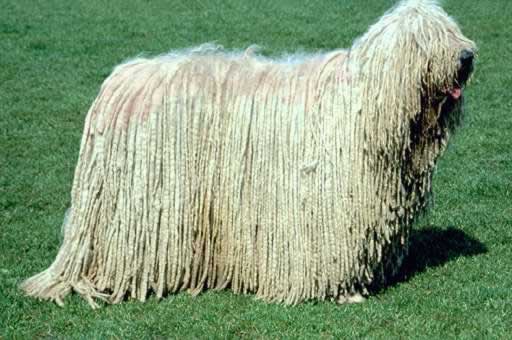 |
|
Komondor Dog Females are 27 inches (69cm) at the withers. Male Komondorok are a minimum of 28 inches at the withers, but many are over 30 inches tall, making this one of the larger common breeds of dog. The body is not overly coarse or heavy, however, and people unfamiliar with the breed are often surprised by how quick and agile the dogs are. |
 |
| Angora Rabbit The Angora rabbit is a variety of domestic rabbit bred for its long, soft hair. The Angora is one of the oldest types of domestic rabbit, originating in Ankara, Turkey, along with the Angora cat and Angora goat. The rabbits were popular pets with French royalty in the mid 1700s, and spread to other parts of Europe by the end of the century. They first appeared in the United States in the early 1900s. They are bred largely for their long wool, which may be removed by shearing or plucking (gently pulling loose wool). There are many individual breeds of Angora rabbits, four of which are ARBA recognized. Such breeds include, French, German, Giant, English, Satin, Chinese, Swiss, Finnish, to name a few. |
 |
| Red Panda The Red Panda, Ailurus fulgens ("shining cat," from a Latinized form of the Greek, ailouros, "cat," and the participial form of the Latin fulgere, "to shine") is a mostly herbivorous mammal, slightly larger than a domestic cat (55 cm long). The Red Panda has semi-retractile claws and, like the Giant Panda, has a "false thumb" which is really an extension of the wrist bone. Thick fur on the soles of the feet offers protection from cold and hides scent glands. The Red Panda is native to the Himalayas in Nepal and southern China. The word panda is derived from Nepalese word "ponya" which means bamboo and plants eating animals in Nepal. |
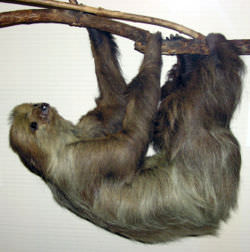 |
| Sloth Sloths are medium-sized mammals that live in Central and South America belonging to the families Megalonychidae and Bradypodidae, part of the order Pilosa. Most scientists call these two families the Folivora suborder, while some call it Phyllophaga. Sloths are omnivores. They may eat insects, small lizards and carrion, but their diet consists mostly of buds, tender shoots, and leaves. Sloths have made extraordinary adaptations to an arboreal browsing lifestyle. Leaves, their main food source, provide very little energy or nutrition and do not digest easily: sloths have very large, specialized, slow-acting stomachs with multiple compartments in which symbiotic bacteria break down the tough leaves. As much as two-thirds of a well-fed sloth's body-weight consists of the contents of its stomach, and the digestive process can take as long as a month or more to complete. Even so, leaves provide little energy, and sloths deal with this by a range of economy measures: they have very low metabolic rates (less than half of that expected for a creature of their size), and maintain low body temperatures when active (30 to 34 degrees Celsius or 86 to 93 degrees Fahrenheit), and still lower temperatures when resting. Sloths mainly live in Cecropia trees. |
 |
| Emperor Tamarin The Emperor Tamarin (Saguinus imperator) is a tamarin allegedly named for its similarity with the German emperor Wilhelm II. The name was first intended as a joke, but has become the official scientific name. This tamarin lives in the southwest Amazon Basin, in east Peru, north Bolivia and in the west Brazilian states of Acre and Amazonas. The fur of the Emperor Tamarin is predominantly grey colored, with yellowish speckles on its chest. The hands and feet are black and the tail is brown. Outstanding is its long, white mustache, which extends to both sides beyond the shoulders. The animal reaches a length of 24 to 26 cm, plus a 35 cm long tail. It weighs approximately 300 to 400 g. This primate inhabits tropical rain forests, living deep in the forest and also in open tree-covered areas. It is a diurnal animal, spending the majority of its days in the trees with quick, safe movements and broad jumps among the limbs. |
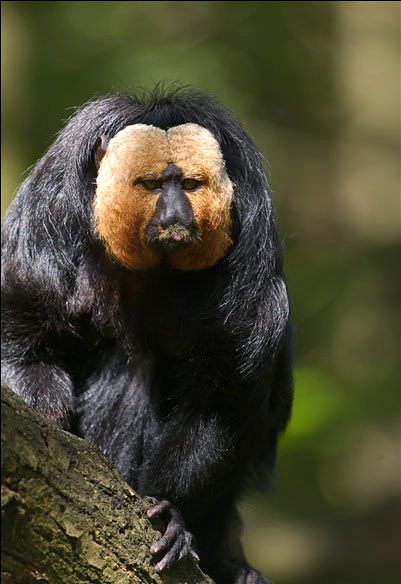 |
| White-faced Saki Monkey The White-faced Saki (Pithecia pithecia), also known as the Guianan Saki and the Golden-faced Saki, is a species of saki monkey, a type of New World monkey, found in Brazil, French Guiana, Guyana, Suriname, and Venezuela. This monkey mostly feed on fruits, but also nuts, seeds, and insects. |
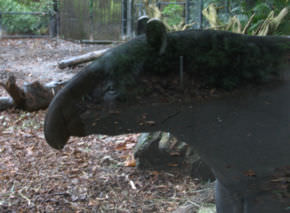 |
| Tapir Tapirs are large browsing mammals, roughly pig-like in shape, with short, prehensile snouts. They inhabit jungle and forest regions of South America, Central America, and Southeast Asia. All four species of tapir are classified as endangered or vulnerable. Their closest relatives are the other odd-toed ungulates, horses and rhinoceroses. |
 |
| Hagfish Hagfish are marine craniates of the class Myxini, also known as Hyperotreti. Despite their name, there is some debate about whether they are strictly fish (as there is for lampreys), since they belong to a much more primitive lineage than any other group that is commonly defined fish (Chondrichthyes and Osteichthyes). Their unusual feeding habits and slime-producing capabilities have led members of the scientific and popular media to dub the hagfish as the most "disgusting" of all sea creatures. Hagfish are long, vermiform and can exude copious quantities of a sticky slime or mucus (from which the typical species Myxine glutinosa was named). When captured and held by the tail, they escape by secreting the fibrous slime, which turns into a thick and sticky gel when combined with water, and then cleaning off by tying themselves in an overhand knot which works its way from the head to the tail of the animal, scraping off the slime as it goes. Some authorities conjecture that this singular behavior may assist them in extricating themselves from the jaws of predatory fish. However, the "sliming" also seems to act as a distraction to predators, and free-swimming hagfish are seen to "slime" when agitated and will later clear the mucus off by way of the same travelling-knot behavior. |
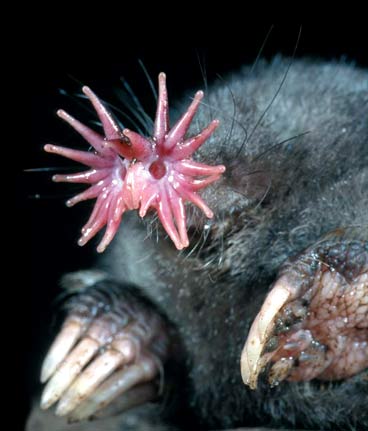 |
| Star-nosed Mole The Star-nosed Mole (Condylura cristata) is a small North American mole found in eastern Canada and the north-eastern United States. It is the only member of the tribe Condylurini and the genus Condylura. It lives in wet lowland areas and eats small invertebrates, aquatic insects, worms and molluscs. It is a good swimmer and can forage along the bottoms of streams and ponds. Like other moles, this animal digs shallow surface tunnels for foraging; often, these tunnels exit underwater. It is active day and night and remains active in winter, when it has been observed tunnelling through the snow and swimming in ice-covered streams. Little is known about the social behavior of the species, but it is suspected that it is colonial. The Star-nosed Mole is covered in thick blackish brown water-repellent fur and has large scaled feet and a long thick tail, which appears to function as a fat storage reserve for the spring breeding season. Adults are 15 to 20 cm in length, weigh about 55 g, and have 44 teeth. The mole's most distinctive feature is a circle of 22 mobile, pink, fleshy tentacles at the end of the snout. These are used to identify food by touch, such as worms, insects and crustaceans. |
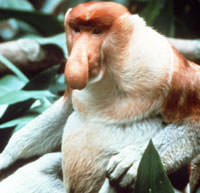 |
| Proboscis Monkey Nasalis larvatus also known as Long-nosed Monkey is a reddish-brown arboreal Old World monkey. It is the only species in monotypic genus Nasalis. The most distinctive trait of this monkey is the male's large protruding nose. The purpose of the large nose is unclear, but it has been suggested that it is a result of sexual selection. The female Proboscis Monkey prefers big-nosed male, thus propagating the trait. Males are much larger than females, reaching 72 cm (28 inches) in length, with an up to 75 cm tail, and weighing up to 24 kg (53 pounds). Females are up to 60 cm long, weighing up to 12 kg (26 lb). The Proboscis Monkey also has a large belly, as a result of its diet. Its digestive system is divided into several parts, with distinctive gut flora, which help in digesting leaves. This digestive process releases a lot of gas, resulting in the monkey's "bloated" bellies. A side-effect of this unique digestive system is that it is unable to digest ripe fruit, unlike most other simians. The diet consists mainly of fruits, seeds and leaves. |
 |
| Pink Fairy Armadillo The Pink Fairy Armadillo (Chlamyphorus truncatus) or Pichiciego is the smallest species of armadillo (mammals of the family Dasypodidae, mostly known for having a bony armor shell). It is approximately 90-115 mm (3?-4?") long excluding the tail, and is pale rose or pink in color. It is found in central Argentina where it inhabits dry grasslands and sandy plains with thorn bushes and cacti. It has the ability to bury itself completely in a matter of seconds if frightened. The Pink Fairy Armadillo burrows small holes near ant colonies in dry dirt. It feeds mainly on ants and ant larvae near its burrow. Occasionally it feeds on worms, snails, insects and larvae, or various plant and root material. |
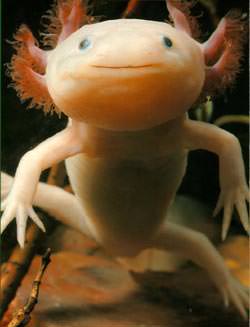 |
| Axolotl The Axolotl (or ajolote) (Ambystoma mexicanum) is the best-known of the Mexican neotenic mole salamanders belonging to the Tiger Salamander complex. Larvae of this species fail to undergo metamorphosis, so the adults remain aquatic and gilled. The species originates from the lake underlying Mexico City. Axolotls are used extensively in scientific research due to their ability to regenerate most body parts, ease of breeding, and large embryos. They are commonly kept as pets in the United States, Great Britain, Australia, Japan (where they are sold under the name Wooper Rooper, and other countries. Axolotls should not be confused with waterdogs, the larval stage of the closely related Tiger Salamanders (Ambystoma tigrinum and Ambystoma mavortium), which is widespread in much of North America which also occasionally become neotenic, nor with mudpuppies (Necturus spp.), fully aquatic salamanders which are unrelated to the axolotl but which bear a superficial resemblance. |
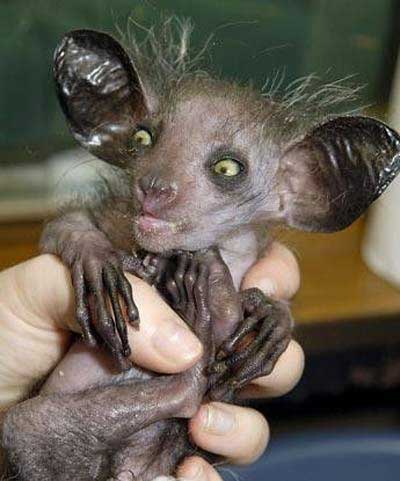 |
| Aye-aye The Aye-aye (Daubentonia madagascariensis) is a strepsirrhine native to Madagascar that combines rodent-like teeth with a long, thin middle finger to fill the same ecological niche as a woodpecker. It is the world's largest nocturnal primate, and is characterized by its unique method of finding food; it taps on trees to find grubs, then gnaws holes in the wood and inserts its elongated middle finger to pull the grubs out. Daubentonia is the only genus in the family Daubentoniidae and infraorder Chiromyiformes. The Aye-aye is the only extant member of the genus (although it is currently an endangered species); a second species (Daubentonia robusta) was exterminated over the last few centuries. |
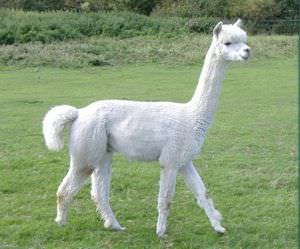 |
| Alpaca The Alpaca (Vicugna pacos) is a domesticated species of South American camelid developed from the wild alpacas. It resembles a sheep in appearance, but is larger and has a long erect neck as well as coming in many colors, whereas sheep are generally bred to be white and black. Alpacas are kept in herds that graze on the level heights of the Andes of Ecuador, southern Peru, northern Bolivia, and northern Chile at an altitude of 3500 to 5000 meters above sea-level, throughout the year. Alpacas are considerably smaller than llamas, and unlike them are not used as beasts of burden but are valued only for their fiber. Alpacas only have fleece fibers, not woolen fibers, used for making knitted and woven items much as sheeps wool is. These items include blankets, sweaters, hats, gloves, scarves, a wide variety of textiles and ponchos in South America, and sweaters, socks and coats in other parts of the world. The fiber comes in more than 52 natural colors as classified in Peru, 12 as classified in Australia and 22 as classified in America. |
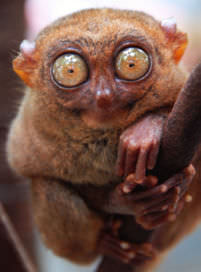 |
| Tarsier Tarsiers are prosimian primates of the genus Tarsius, a monotypic genus in the family Tarsiidae, which is itself the lone extant family within the infraorder Tarsiiformes. The phylogenetic position of extant tarsiers within the order Primates has been debated for much of the past century, and tarsiers have alternately been classified with strepsirrhine primates in the suborder Prosimii, or as the sister group to the simians (=Anthropoidea) in the infraorder Haplorrhini. Analysis of SINE insertions, a type of macromutation to the DNA, is argued to offer very persuasive evidence for the monophyly of Haplorrhini, where other lines of evidence, such as DNA sequence data, had remained ambiguous. Thus, some systematists argue that the debate is conclusively settled in favor of a monophyletic Haplorrhini. Tarsiers have enormous eyes and long feet. Their feet have extremely elongated tarsus bones, which is how they got their name. They are primarily insectivorous, and catch insects by jumping at them. They are also known to prey on birds and snakes. As they jump from tree to tree, tarsiers can catch even birds in motion.[citation needed] Gestation takes about six months, and tarsiers give birth to single offspring. All tarsier species are nocturnal in their habits, but like many nocturnal organisms some individuals may show more or less activity during the daytime. Unlike many nocturnal animals, however, tarsiers lack a light-reflecting area (tapetum lucidum) of the eye. They also have a fovea, atypical for nocturnal animals. |
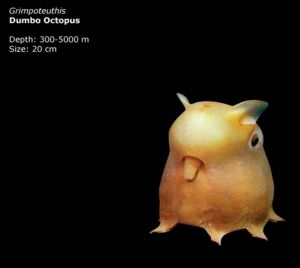 |
| Dumbo Octopus The octopuses of the genus Grimpoteuthis are sometimes nicknamed "Dumbo octopuses" from the ear-like fins protruding from the top of their "heads" (actually bodies), resembling the ears of Walt Disney's flying elephant. They are benthic creatures, living at extreme depths, and are some of the rarest of the Octopoda species. |
 |
| Frill-necked Lizard The Frill-necked Lizard, or Frilled Lizard also known as the Frilled Dragon, (Chlamydosaurus kingii) is so called because of the large ruff of skin which usually lies folded back against its head and neck. The neck frill is supported by long spines of cartilage, and when the lizard is frightened, it gapes its mouth showing a bright pink or yellow lining, and the frill flares out, displaying bright orange and red scales. The frill may also aid in thermoregulation. They may grow up to one metre in total length. They often walk quadrupedally when on the ground. When frightened they begin to run on all-fours and then accelerate onto the hind-legs. In Australia, the frill-necked lizard is also known as the "bicycle lizard" because of this behaviour. Males are significantly larger than females both as juveniles and when mature. The frill of the Australian frilled dragon is used to frighten off potential predators — as well as hissing and lunging. If this fails to ward off the threat, the lizard flees bipedally to a nearby tree where it climbs to the top and relies on camouflage to keep it hidden. |
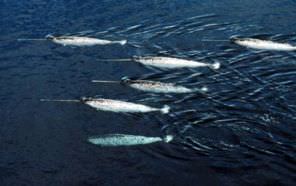 |
| Narwhal The Narwhal (Monodon monoceros) is an Arctic species of cetacean. It is a creature rarely found south of latitude 70°N. It is one of two species of white whale in the Monodontidae family (the other is the beluga whale). It is possibly also related to the Irrawaddy dolphin. The English name narwhal is derived from the Dutch name narwal which in turn comes from the Danish narhval which is based on the Old Norse word nar, meaning "corpse." This is a reference to the animal's colour. The narwhal is also commonly known as the Moon Whale. In some parts of the world, the Narwhal is colloquially referred to as a "reamfish." |
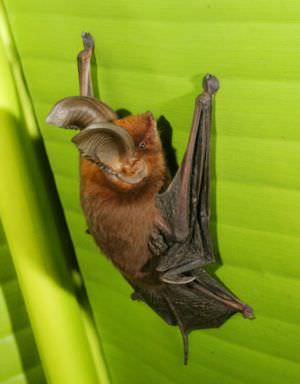 |
| Sucker-footed Bat The Madagascar Sucker-footed Bat, Old World Sucker-footed Bat, or Sucker-footed Bat (Myzopoda aurita and Myzopoda schliemanni) is a species of bat in the Myzopodidae family. It is monotypic within the genus Myzopoda. It is endemic to Madagascar. It is threatened by habitat loss. |